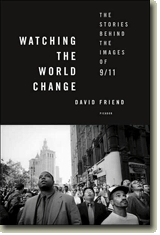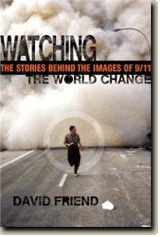September 2009 Archives
« Previous · Home · Next »
September 30, 2009
ORNETTE'S SAX DRIVE
Though this blog is about 21st century visual culture, as explored in the book Watching the World Change, every so often I encounter a non-visual aspect of the culture that I feel I just have to write about….
On Friday evening, "free jazz" pioneer Ornette Coleman, age 79, made his debut at New York’s Jazz at Lincoln Center, disgorging propulsive, mordant discordance from his sax, trumpet, and violin – often during the course of a single song -- in the premiere event of the new JALC season.
In 1930, the year of Coleman’s birth, novelist James Joyce was consumed with writing his last masterpiece, Finnegans Wake (published in 1939) – in some ways a literary precursor to bebop, modern jazz, and to Coleman’s circuitous, combustible, free jazz idiom. In the spirit of Coleman and Finnegan, herewith: an homage to Friday’s performance by Coleman, his son Denardo (on drums) and a double-bass tag team of Anthony Falanga (acoustic) and Al McDowell (electric)...
Bopgoblin moogoogle flugelhornettish coquettery. Cornettishistic scatterwalling poco loco rococo. Ornery orotund knottypine fandango. Ornate atonal contrapuntificat, all scatterscat, this swarm-snarling stacattornado hailspawning and tailspinning at, say, 300 Bird-Miles-an-hour.
Sated and satiated by that mood indigogo goo-spewed stew of gogobootilicioius ornetti orecchiette, with bacchanalli rabe. Festooned with a festering blistering fistulae of throbbing gristlewhistle. Try the combo-jumbo mumbo, that turbo-Trumbo mumble-gambol gumbo, those comafunktose piston-hissssin, valvoline-sheened crankcase flakes.
Hark the Googleplexiconstantinobalisque, oeuvreshadowcasting all. Check out that rhomboid porkpie-lidded Daddy-o, the balderdishdasha maharishi, the globo-boho oboe-toting hobo on that doom-domed dromedarian recalcitrantic mantis. Lisssssssin to the eardrumkitandkaboodle, the swoondoogled toggle-snuggled unpluggeried glug-glug-gluggery.
Fallopium tubularity recapostulates the phallogenie. The vortiginous oronoconnoiters with His Infinitessimillogical Fractallusiveness.
Parasolipsustenant percussteraneous bloody bleebop agitpop. Asymphonic tonic-and-Sapphire. Freakopediant cybelencyclical. Fever-dream, swine-fluted tympandemonium. Cymbalumbilicalifragilisticalifornication.
Relativoltaic Einsteinian steinwayfarers! Rosenclank und Guildensturm-und-dranglers! Cascading tjader-esque bags-groovin’ rassanrollin’ sonnyrollickin’ monkful birdybyrdian dizzydecorous coltransistored dexter-beiderbexterous, itty-bitty-ubiquititty-rhythmsticketty, massive-assive clavichordant ornithologists, All! Percussin’ cuzzins...Ayyyy, men.
September 18, 2009
Mistaken Memory?
I'm in Toronto for the imminent unveiling of the exhibition "Vanity Fair Portraits, 1913-2008" - the final leg of a three-continent, five-venue tour. The exhibition, jointly curated by Vanity Fair and the National Portrait Gallery, London, appears at the Royal Ontario Museum, through January 4, 2010, having broken attendance records in London and Edinburgh and drawing throngs in Los Angeles and Canberra, Australia.
While here, I received this enlightening e-mail.
From Lloyd Chang, Singapore:
Dear Mr Friend,
I have just begun reading your book Watching the World Change, which I find that I can especially appreciate as a serious amateur photographer.
Prior to purchasing your book (which takes a while for Amazon to ship to Singapore), I had read Tom Junod's article ["The Falling Man," concerning the identity of a Wolrd Trade tower worker who tumbled to his death on 9/11] in Esquire, and viewed the Henry Singer documentary based on it.
I then came across your blog. In 2006 and 2008, two readers wrote to you about a different falling man, not the one in [AP photographer] Richard Drew's photo. They seemed to recall an image of someone whose tie was flapping in the wind, an image of which "half of the background was building, about half the sky".
You mentioned in your blog that you had not been able to identify the image, though you had some recollection of it. I too recall something that resembles the description of this image.
I believe the photograph in question is "Victims Jump" by David Surowiecki, for Getty Images. Jumpers are seen across a clear sky, which occupies about a third of the frame.
It ran in the special commemorative issue of Time magazine, where it was given a full 2-page spread. I have a copy of it and the caption below it reads: ""You saw their ties flying up in the air," recalls David Burrell, a broker who watched several people fall of jump to their death."
The photograph can be seen HERE.
The thumbnail image, of course, is too small to make out the details, but in the 2-page spread in Time, the falling figures are quite clear. It is not evident that anybody's tie is flying in the wind, however, though it looks as if one of the jumper's socks is being torn away from his foot by the turbulence and has a trailing, wispy appearance. Perhaps the description in the caption mistakenly fused with the memory of the image.
I hope this helps to shed some light for you and your readers.
Best regards
Lloyd Chan
NOTE: This might be the reason several of us recalled a photo of a man with a "tie flying up": the caption, as Lloyd Chan suggests, may have "mistakenly fused with the memory of the image."
September 12, 2009
The Horror, 2009
A must read. Alexia Tsotsis, on L.A. Weekly’s Art Blog weighs in on how the events of September 11 would have been channeled through the culture had the attacks occurred in 2009. It is reminiscent of the remarks from Watching the World Change in which former Paris Match editor Alain Genestar notes that had the assault been waged today we would have had people inside the towers taking real-time cell-phone photographs and uploading them onto their computers for all to see.
As Kurtz says in Francis Ford Coppola's Apocalypse Now, echoing Joseph Conrad’s Heart of Darkness: “The horror, the horror.”
As Tsotsis notes, "For the most part we spent 9-11 watching CNN. The Web in '09 is more about doing rather than watching. Twitter asks, 'What are you doing RIGHT NOW?'"
September 11, 2009
ON THE EVE OF 9/11
This week I attended one memorial service (for CBS News anchor Walter Cronkite, at Lincoln Center, on Wednesday) and one funeral mass (for Vanity Fair columnist Dominick Dunne, at Saint Vincent’s Church, yesterday). At the services, attended by many of New York’s leading lights of journalism, the talk was often about the passing of an age, the end of an era, the withering away of their trade and passion among an ever diminishing legion of practitioners: the pursuit of the truth in broadcast news (in Cronkite’s case); the pursuit of justice through commentary, opinion, gossip, and reportage (in Dunne’s).
But on the eve of September 11, I was moved to consider the passing of these two colleagues in terms of their pure humanity, not in terms of their profession’s mortality. Walter Cronkite and Dominick Dunne were both gregarious, curious, probing, candid, singular, peerless, fearless, self-made men. And in the end, despite battling illness, their friends, colleagues, and families chose to recognize the essential joie de vivre, the unbridled enthusiasm for life, that was ingrained in the very fiber of each man.
"[Walter] always wanted to know everything about everything,” Bob Schieffer observed, about his friend, “and he wanted to know it before everyone…. Walter Cronkite loved the news, and we loved Walter Cronkite for it. What a man."
The program for Dunne’s service quoted the poet Kenneth Rexroth, “We were comrades together. Life was good for us. It is good to be brave – nothing is better. Food tastes better. Wine is more brilliant. Girls are more beautiful. The sky is bluer…. If the good days never come, we will not know. We will not care. Our lives were the best. We were the happiest men alive in our day.”
At Cronkite’s ceremony, the U.S. Marine Corps Band played Sousa and Wynton Marsalis led a sextet on a New Orleans-style funeral procession, blasting “When the Saints Go Marching In.” At Dunne’s mass, vocalist Jack Donahue not only sang, “The Battle Hymn of the Republic” but also Cole Porter’s “Anything Goes.” This was the soundtrack of joie de vivre.
September 8, 2009
FROM THE ASHES, A SPARK OF UTOPIA
This September 11, among the aspects of the tragedy of 2001 that might be worth considering: the tremendous sense of civic spirit and altruism that emerged in the hours, days, and weeks after the attacks.
That theme is evident in a new book, out this month from Rebecca Solnit, A Paradise Built in Hell: The Extraordinary Communities That Arise in Disaster, in which she discusses community action in the aftermath of various calamities (the 1906 San Francisco earthquake, 9/11, Hurricane Katrina, among them).
To listen to an excerpt of Solnit reading from the book, visit VanityFair.com.



